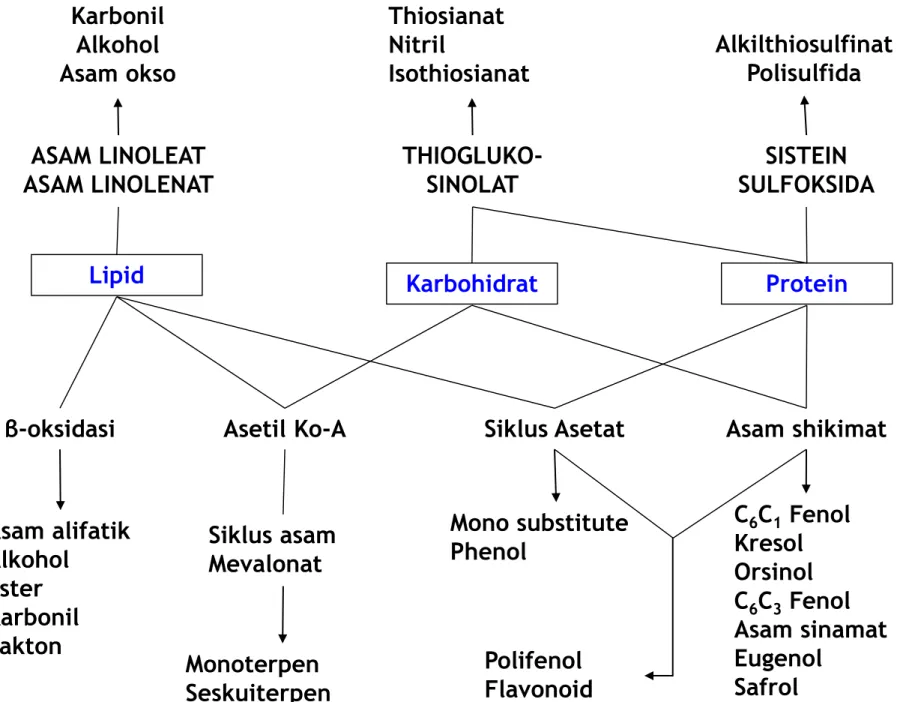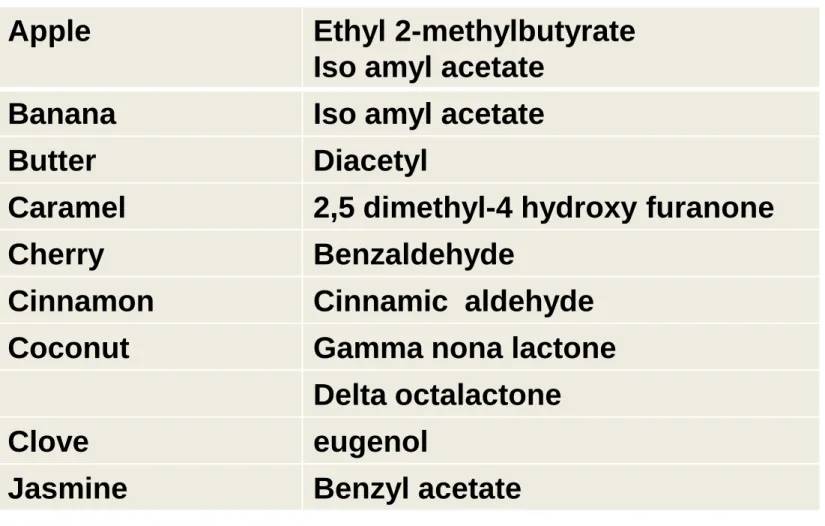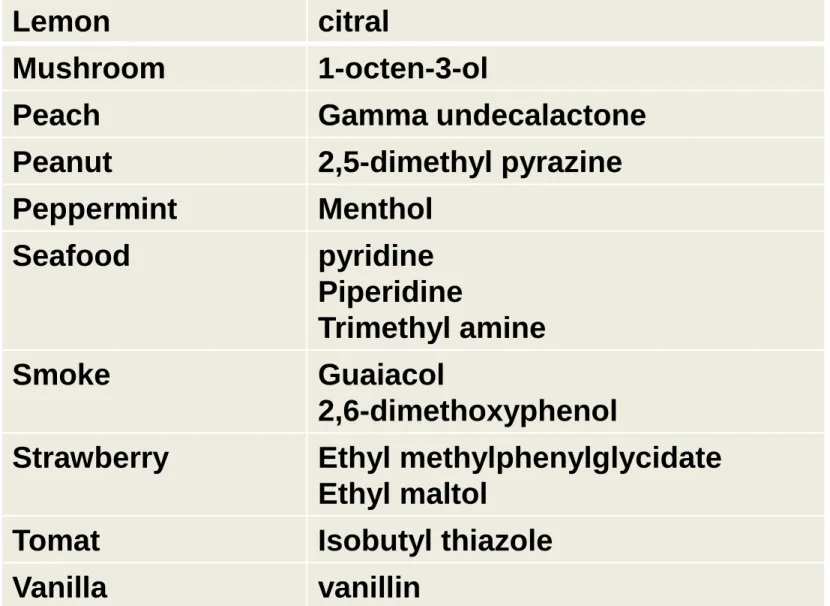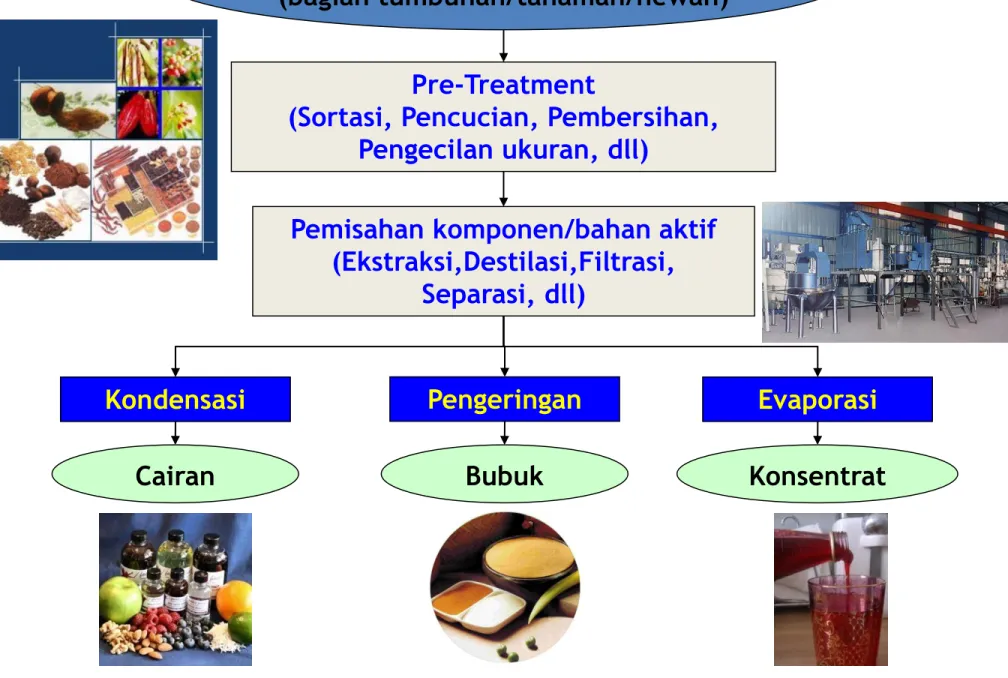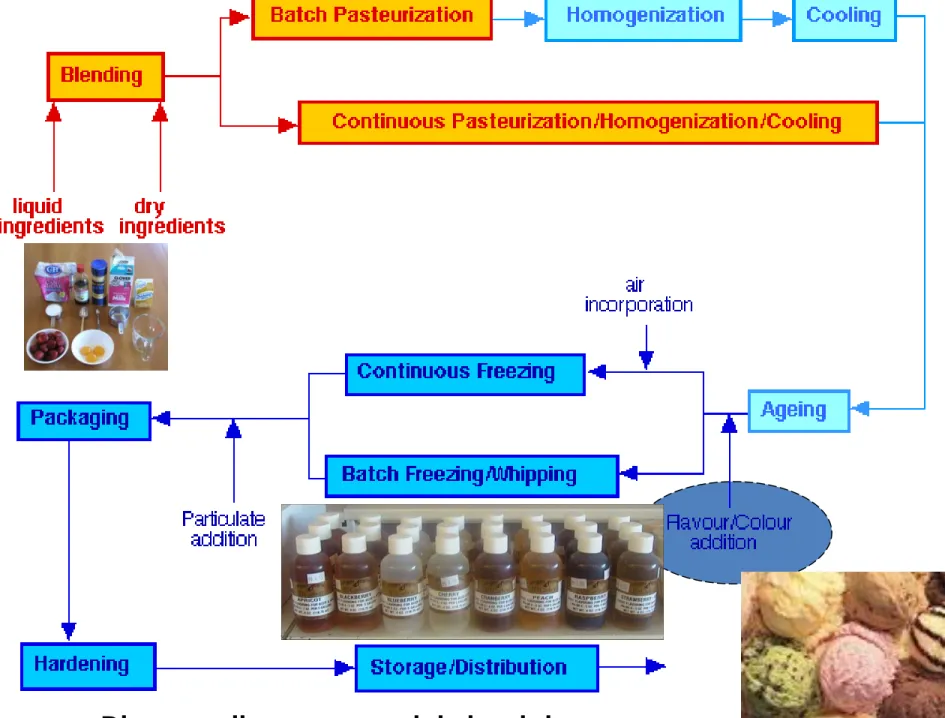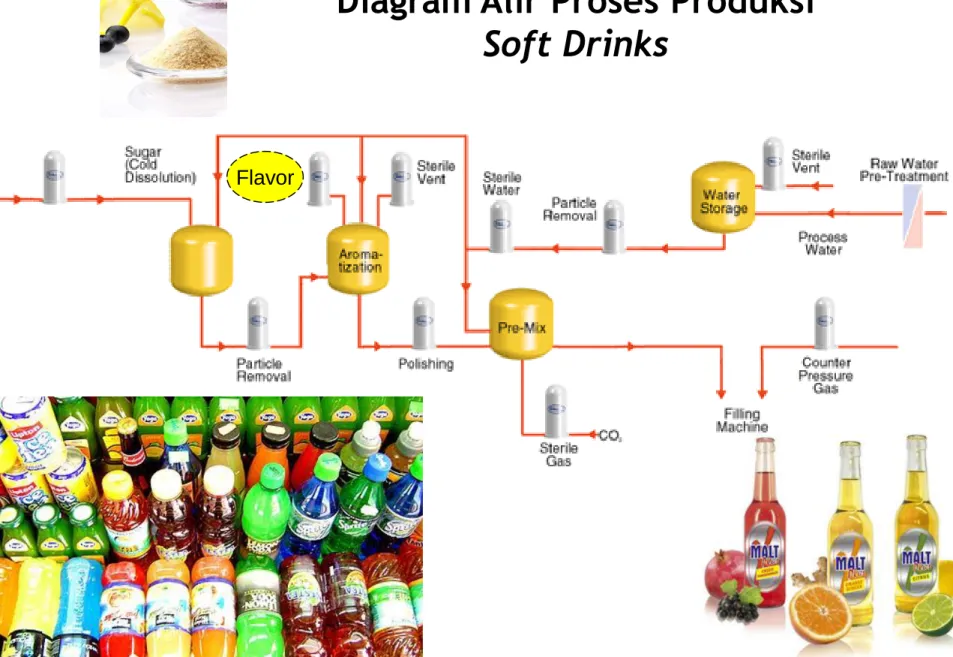FLAVOR
(PERISA)
Definition of Flavor
Integrate response to a complex mixture of
stimuli primarily on the senses of smell and taste, but also on those associated with sight (color
and appearance), tactile sensation (texture and mouth feel) and pain (pungency)
Flavor is one of the important qualities of foods which are decisive in the selection, acceptance, and ingestion of a food.
Stimulus Senses Sensory Response
Taste
Food Flavor
Odor
Substansi rasa : manis, pahit, asam, dan asin
Manis grup hidroksi (molekul gula), sakarin, kloroform
Asam ion hidronium (H3O+)
Pahit pahit dan manis berasal dari kelompok yang sama, dengan perbedaan tergantung pada stereokimia molekul stimulus Contoh : -Asam amino D-isomer manis, L-isomer pahit
-Sakarin manis, tapi terlalu banyak menyebabkan rasa pahit
-Fenil tiokarbamida, Kreatin
-Alkaloid quinone, kafein, teobromin Asin rasa asin klasik : NaCl dan LiCl
Alternatif : garam K dan ammonium
Pada dasarnya lidah hanya mampu mengecap (taste) empat jenis rasa: yaitu pahit, asam, asin dan manis.
Flavor enhancer berkontribusi terhadap rasa lezat suatu makanan
Astringency fenomena seperti rasa kesat, rasa kering di mulut, (seperti pengeringan jaringan mulut)
Asosiasi dari tanin atau polifenol dengan protein dalam saliva
Contoh : tanin pada teh
Contoh : - MSG (mono sodium L-glutamat) - 5’IMP (5’ inosin monofosfat)
Pungency sensasi rasa pedas dan tajam
contoh : cabe (capsaicin), merica (piperine), jahe (gingerole)
Cooling sensasi cooling (dingin) terjadi akibat kontak bahan di hidung dan jaringan mulut
contoh : pippermint, spearmint, wintergreen, mentol, camphor
Development of Flavor Substances
a. Flavor substances formed during normal plant & animal metabolism.
*Plant remain in situ when the plant is harvested (example : essential oils, fruit and vegetable flavors).
- Fruit flavor develops during ripening periode
- Vegetables flavor develops during cellular disruption b. Flavoring components resulting from enzyme-catalyzed
reactions (e.g. enzyme-modified dairy products : butter, cheese etc)
c. Flavoring constituent produced as a result of microbiolo- gical action/fermentation (e.g. wines, dairy products, tea) d. Flavor resulting from heat processing or cooking
(e.g. cooked meat flavors, roasted coffee)
Fatty acid metabolism
Carbohydrate
metabolism Amino acid metabolism
Nonvolatile Precursor
Linoleic-
Linolenic acid
Thioglucosino- late
Cystein- Sulfoxides (C-S)
Methyl- methionine
Precursor-splitting Enzyme
Lipoxygenase Thioglucosi- dase
C-S-lyase None (heating) Carbonyls
Alcohols Oxo-acids
Isothiocyanates Nitrilles
Thiocyanates etc
Polysulfides Alkyl-
thiosulfinates
CH-S-CH3
a1. Formation of flavor components in Vegetables
Karbonil Alkohol Asam okso
Thiosianat Nitril
Isothiosianat
Alkilthiosulfinat Polisulfida
ASAM LINOLEAT ASAM LINOLENAT
THIOGLUKO- SINOLAT
SISTEIN SULFOKSIDA
Lipid Karbohidrat Protein
β-oksidasi Asetil Ko-A Siklus Asetat Asam shikimat
Asam alifatik Alkohol
Ester Karbonil Lakton
Siklus asam Mevalonat
Mono substitute Phenol
Monoterpen Seskuiterpen
Polifenol Flavonoid
C6C1 Fenol Kresol Orsinol C6C3 Fenol Asam sinamat Eugenol
Safrol
a2. Diagram Biosintesis Senyawa Flavor Buah-buahan
b. Flavouring substances produced with Enzymes
Product Substrate Enzyme Butyric acid Butter fat Lipase Caproic acid Butter fat Lipase Acetaldehyde Ethanol Alcohol
dehydrogenase
Geranial Geraniol Alcohol
dehydrogenase Cinnamic
alcohol
Cinnamic aldehyde
Alcohol
dehydrogenase Methanethiol Methionine Methioninase Capric acid Butter fat Lipase
c. Flavouring Substances produced by Microbial Fermentation
Microorganism Product
Lactococcus species Leuconostoc species
Diacetyl
Pseudomonas species 3-Isopropyl-2-methoxy pyrazine
Streptococcus lactis Methyl butanol Trichoderma viride 6-pentyl-α-pyrone Bacillus subtilis
Corynebacterium glutamicum
Aspergillus oryzae
Tetramethyl pyrazine
1-octene-3-ol
(mushroom aroma)
d. Flavor Formation During Thermal Processing
(Cooking)
Nonenzymatic Browning
(Maillard browning, caramelization)
e.g. baked bread, steak, freshly brewed coffee or chocolate
*Maillard Browning :
Reaction between carbonyls (reducing sugars) and amines (amino acids/proteins) melanoidin & pyrazine (largest contribution to flavor of chocolate)
Formation of Flavor Compound via Maillard Reaction :
Aliphatic aldehydes, ketones, diketones & lower chain length fatty acids
*Caramelization : sugars thermally decomposed at >1500C, more rapidly at at high pH
Deep Fat Fried Flavor :
a. Hydrolysis of triglycerides (reaction between triglyceride with water)
a. Oxidation of unsaturated fatty acids
a. Pyrolysis reaction (>2000C, overheated) acrolein (burnt fat : glycerol acrolein)
Bawang Putih
S-(2-propenil)-L-Sistein Sulfoksida =Alliin
(prekursor, tidak berbau)
allinase Diallyl thio- sulphinate (Allicin) Contoh Flavor dan Aroma dalam produk Hasil
Pertanian
When fresh garlic is chopped or crushed, the enzyme allinase converts alliin into allicin which is primarily
responsible for the aroma of fresh garlic.
Allicin :
provides flavor, pungency and bioactive.
help prevent heart disease (including atherosclerosis, high cholesterol, and high blood pressure) and cancer
2 H2C=CH-CH2-S-CH2-CH-COOH NH2 O
H2C=CH-CH2-S-S-CH2-CH=CH2 O
Diallyl thiosulphinate (Allicin)
+H2O-2NH3 -2H3C-CO-COOH
(Alliinase)
H2C=CH-CH2-S-S-CH2-CH=CH2
Diallyl disulphide
Other products
H3C-S-S-CH2-CH=CH2
Methylallyl disulphide
*Pembentukan aroma pada Bawang Putih
(Aliin: prekursor tdk berbau) S-Allyl-L-cysteine sulfoxide
The sulfur compound allicin, produced by crushing or chewing fresh garlic produces other sulfur
compounds : allyl sulfides, ajoene, and vinyldithiins.
When a cell is broken by chopping, chewing, or crushing, enzymes stored in cell vacuoles trigger the breakdown of several sulfur-containing compounds stored in the cell fluids.
The resultant compounds are responsible for the sharp or hot taste and strong smell of garlic.
Diallyl disulfide is believed to be an important odour component.
Allicin has been found to be the compound most responsible for the "hot" sensation of raw garlic. The process of cooking garlic removes allicin, thus mellowing its spiciness
Kopi
Selama penyangraian :
Karbohidrat (gula) karamelisasi Asam amino pirolisis
Tanin bahan fenolik volatil
Flavor kopi kafein, asam, senyawa fenol, dan senyawa volatil hasil dari penyangraian biji kopi
(200-250oC, 20-30 menit).
Flavor asam tergantung senyawa asam klorogenat, asam quinat
Coffee Bean Roasting (approximately 200°C) :
Caramelization occurs as intense heat breaks down starches in the bean, changing them to simple sugars that begin to brown, changing the color of the bean.
Sucrose is rapidly lost during the roasting process and may disappear entirely in darker roasts.
During roasting :
aromatic oils, acids, and caffeine weaken, changing the flavor
at 205°C, other oils start to develop. One of these aromatic oil is caffeol, created at about 200°C, which is largely responsible for coffee's aroma & flavor.
Tambahan Info
Tea contains :
- Catechins, a type of antioxidant (highest in
concentration in green tea, while black tea has
substantially fewer due to its oxidative preparation) - Theanine
- the stimulant caffeine,
- small amounts of theobromine, theophylline and fluoride
Teh
- Leaves of Camellia sinensis soon begin to wilt and oxidize if not dried quickly after picking.
- The leaves turn progressively darker as their
chlorophyll breaks down and tannins are released. This process, enzymatic oxidation, is called fermentation in the tea industry, although it is not a true fermentation:
it is not caused by microorganisms, and is not an anaerobic process.
The next step in processing is to stop the oxidation process at a predetermined stage by heating, which deactivates the enzymes responsible.
With black tea this is done simultaneously with drying.
Tea Processing
Tambahan Info
Teh :
Pengaruh proses terhadap aroma teh
Tipe proses Produk utama
Oksidasi lipid tidak jenuh - cis-3-heksenol - trans-2 heksenal
Degradasi asam amino Aldehid, sebagian berubah menjadi alkohol
Hidrolisis glikosida terpene Linalool, geraniol Degradasi karotenoid Monoterpen
Flow Diagram of Chocolate Production
Step 1: cocoa beans
Step 2: shell and nibs
Step 3: cocoa powder Step 4: plain chocolate Senyawa : Theobromin (stimulating) & tannin (color & taste)
Flavor Daging
Beberapa bahan yang biasa digunakan untuk meningkatkan flavor daging :
- Hidrolisat protein tanaman/HVP - Otolisat khamir (yeast extract) - Lemak hewan tertentu
- Tepung Telur ayam - Gliserol
- Glutatione
- Glukosa - Arabinosa
- 5’-ribonukleotida - Metionin
- MSG
- Thiamin (Vit. B1) - Sistein
Thiazole flavor daging rebus
2-metil-3-furantiol flavor daging bakar
The Maillard reaction occurs when the denatured
proteins on the surface of the meat recombine with the sugars present.
The combination creates the "meaty" flavor and
changes the color. For this reason, it is also called the browning reaction. The Maillard reaction occurs most readily at around 300° F to 500° F.
When meat is cooked, the outside reaches a higher temperature than the inside, triggering the Maillard reaction and creating the strongest flavors on the surface.
http://www.exploratorium.edu/cooking/meat/INT-what-makes-flavor.html
Ingredients of Flavouring
Flavouring consist of :
• 1. Flavouring ingredients : Flavouring substances
natural, natur-identical, artificial
• 2. Non-flavouring ingredients :
Flavor adjunct, flavor enhancer
1. Flavouring Ingredients
Flavouring Substances are defined chemical component with flavouring properties, not
intended to be consumed as such and categorized as :
a. Natural Flavouring Substances : defined substance obtained by appropriate
physical, microbiological, or enzymatic processes from foodstuff or material of vegetable or animal origin as such (natural state) or after processing by food preparation processes.
Can not contain any nature-identical or artificial flavoring substances
Natural Flavoring
“The term “Natural Flavoring” or “Natural Flavor”
means :
essential oil, oleoresin, essence or extractive, protein hydrolysate, distillate, or any product of roasting, heating or enzymolysis, which contains the flavoring constituents derived from natural sources : spice, fruit, or fruit juice, vegetable or
vegetable, edible yeast, herb-plant material, meat, seafood, poultry, eggs, dairy products, or
fermentation products whose significant function in food is flavoring rather than nutritional”
- b. Nature-Identical Flavouring Substances :
flavouring substances obtained by synthesis or isolated through chemical processes from a natural aromatic
material and chemically identical to a substance present in natural products intended for human consumption,
either processed or not
• In general are members of chemical groups like aliphatic alcohol, aldehydes, ketones, acetals, acids, esters,
heterocyclics, phenols, phenolesters, sulphides, thiols.
• Manufactured mostly by esterification, oxidation, or
Grignard reaction from essential oils or terpene fractions thereof, fats and mineral oils derivatives.
These are typically produced by fractional distillation and additional chemical manipulation naturally sourced chemicals or from crude oil or coal tar.
c. Artificial Flavouring Substances :
flavouring substances, not yet identified in a natural product intended for human consumption, either
processed or not.
Vanillin
www.fantastic-flavour.com/natural_vanilla
Example
• Vanillin (4-hydroxy-3-methoxybenzaldehyde):
starting material is guaiacol
• Ethyl vanillin : starting material is guaiene Artificial Flavouring Substances :
Vanillin
www.fantastic-flavour.com/natural_vanilla
2. Non Flavouring Ingredient :
Flavour adjunct :
food additives and food ingredients necessary for the production, storage and application of flavouring as far as they are non-functional in the finished food
Example :
• Solvent : water, glycerol, triacetine, ethanol, propylene glycol (PG), vegetable oil, triethyl citrate, benzyl alcohol
• Carrier : modified starch (maltodextrine), lactose, gelatin
• Emulsifier/stabilizer : mono/diglycerides, gelatine
• Colorant
• Processing aids (enzyme) : microbial or animal derived
Flavour enhancer :
substance with little or no odour at the level used, the primary purpose of which is to increase the flavour
effect of certain food components well beyond any flavour contributed directly by the substance itself
• Example : - MSG
- Ribotide (I+G)
- Sugar, salt & vinegar
Example of Vegetable Based Material
:• Plant extract (e.g. fruit juices, essential oil, oleoresin,etc.)
• HVP (hydrolyzed vegetable protein) soy protein hydrolyzed by acid or enzyme
• Flavouring substances isolated from essential oil (e.g. anethol, benzaldehyde, eugenol, citral, dimethyl
sulfide, etc.)
• Dried spices & herbs
Example of Animal Based Materials :
• Meat & fat (fresh, dried, extract)
• Milk & its derivatives
• Fatty acids
• Amino acids (e.g. cysteine, cystine (can be from human hair/feather) & phenylalanine )
www.tradeindia.com/.../
Meat-Extract- Paste.htm
• Animal secretion :
- Ambergris or ambra (intestinal tract of the sperm or cachalot whale)
- Civet absolute (odorous glandular secretion of male and female civet)
- Musk absolute (glandular secretion of the male musk deer, found in an internal pouch located under the skin of the
abdomen)
identics.tripod.com/parfum/bahan_aromatis.htm
Civet (Kesturi)
musk deer ikan paus
Jenis Flavor Berdasarkan sumber dan proses pembuatannya :
1. Flavor natural/alami
2. Flavor Natural identical (diolah dari bahan alami untuk menghasilkan flavor sintetis).
3. Flavor Artifisial/Sintetis (buatan) Flavor natural/alami dibuat atau
diekstraksi dari bahan-bahan alami, misalnya rasa bawang yang diambil dari ekstrak bawang, rasa ayam yang
diperoleh dari sari ayam, rasa udang yang berasal dari tepung udang, dll
Perisa natural identical disusun dari bahan-bahan alami untuk menghasilkan rasa yang identik dgn yg ada di alam misalnya
turunan dari minuman keras yang bisa disintesa menjadi berbagai perisa
buah-buahan.
Contohnya fussel oil yang merupakan
produk samping dari minuman keras, bisa digunakan sebagai bahan penyusun
perasa stroberi, leci, dan nanas.
Sebenarnya bahan-bahan tersebut adalah bahan alami, tetapi kemudian
direaksikan dengan bahan-bahan lainnya dan menghasilkan rasa tertentu yang
dikehendaki.
Perisa buatan/sintetis (artifisial) dihasilkan dari bahan-bahan
sintetis/reaksi kimia, contohnya sintesis bahan-bahan kimia yang berasal dari turunan minyak bumi.
• butil cinamaldehid yang memiliki rasa mirip dengan bunga (melati dan lili)
• butil butirat yang memiliki rasa mirip buah-buahan pir dan nanas
• Berbagai asam amino yang bisa mirip rasa daging atau ayam.
Contoh
Flavor terdiri dari berbagai jenis Salah jenis molekul dasar yang dapat dimodifikasi untuk membentuk komponen aroma yang
berbeda, contohnya adalah dicyclopentadiene (DCPD)
CONTOH KOMPONEN PENYUSUN FLAVOR
FLAVOR CREATION : 2 cara/pendekatan
1. Metode tradisonal untuk menciptakan formula konstituen flavor utama yang diketahui lalu diatur nuasanya dgn menambahkan bahan flavor dgn karakter odor/flavor yg diketahui tergantung pengalaman flavoristnya
2. Pendekatan ilmiah, menciptakan formula flavor
menggunakan hasil analisis dg Gas Kromatografi/alat lain menghasilkan profil flavor, tapi ada komponen flavor yang tak terdeteksi ) disebabkan error
/keterbatasan alat saat analisis
terbaik kombinasi keduanya
FLAVOR BREAKDOWN
Flavor break down into : flavor (character, contributory and differential) + diluent
Character Impact : when smelled, that are clearly reminiscent of the named flavor. This could be a pure
flavor chemical ( e.g citral for lemon) or a natural material (e.g fenugreek for maple). See Table 1.
Flavor Contributory : these components help develop the named flavor, They have a character similar to that of the named flavor (e.g. oil of tagette for apple, orris root for raspberry and ethyl butyrate for grape)
Flavor Differential : these components contribute
different unique notes to the flavor (e.g. peppermint for vanillin flavor, jasmine for strawberry flavor, menthol for flavor butterscotch)
Table 1. Character Impact
Apple Ethyl 2-methylbutyrate Iso amyl acetate
Banana Iso amyl acetate
Butter Diacetyl
Caramel 2,5 dimethyl-4 hydroxy furanone
Cherry Benzaldehyde
Cinnamon Cinnamic aldehyde Coconut Gamma nona lactone
Delta octalactone
Clove eugenol
Jasmine Benzyl acetate
Table 1. Character Impact (cont.)
Lemon citral
Mushroom 1-octen-3-ol
Peach Gamma undecalactone
Peanut 2,5-dimethyl pyrazine Peppermint Menthol
Seafood pyridine
Piperidine
Trimethyl amine
Smoke Guaiacol
2,6-dimethoxyphenol
Strawberry Ethyl methylphenylglycidate Ethyl maltol
Tomat Isobutyl thiazole
Vanilla vanillin
Diluent = flavor solvent
Flavors are seldom 100 % active components , but more likely only 10-20 %. This is because the individual flavor contituent may not be mutually soluble.
A solvent may therefore be required to keep the flavor from precipitating or undergoing phase separation. The solvent also adds some bulk, which may be desirable in term of manufacturing (i.e. a larger volume to weight or distribute in a food product)
water, glycerol, triacetine, ethanol, propylene glycol (PG), vegetable oil, triethyl citrate, benzyl alcohol
Can be added with other flavor adjuct and or flavor enhancer
FLAVOR MANUFACTURING
1. Raw Materials Handling :
Comminution, sieving, extraction with solvent, pressing, distillation (direct, steam, vacuum, azeotropic) and
sterilization (gas, radiation) 2. Liquid Flavor Production :
Blending and compounding, clarification (filtration, centrifugation), emulsification, homogenization, pasteurization and preservation
3. Dry Flavor Production :
Dehydration, adsorption, spray-drying, microencapsulation, powder blending
Keamanan Flavor
• Keamanan produk (product safety) dan teknik evaluasi keamanan perlu diperhatikan , khususnya dalam penggunaannya didalam bahan pangan.
Evaluasi keamanan bagi senyawa flavor dimulai tahun 1960, di AS terhadap bahan a Aditif atau Bahan Tambahan Pangan.
• Senyawa yang terbukti aman oleh para pakar mendapat Status GRAS (Generally Recognized as Safe)
Di Amerika, evaluasi senyawa flavor dilaksanakan oleh FEMA (The US Flavor and Extract Manufacturer's Association).
• Di Eropa, kegiatan evaluasi keamanan senyawa flavor dilakukan oleh Council of Europe (CoE). CoE mempublikasikan suatu daftar yang berisi senyawa flavor serta sumber alam dari flavor yang disebut "Blue Book".
Bahan Baku
(bagian tumbuhan/tanaman/hewan)
Pre-Treatment (Sortasi, Pencucian, Pembersihan,
Pengecilan ukuran, dll)
Pemisahan komponen/bahan aktif
(Ekstraksi,Destilasi,Filtrasi, Separasi, dll)
Konsentrat Bubuk
Cairan
Evaporasi Pengeringan
Kondensasi
Diagram alir proses produksi flavor
PRODUK FLAVOR
Aplikasi Produk Flavor pada Industri
Penggunaan produk industri flavor dalam
produk-produk pangan dan non pangan relatif sedikit namun besar peranannya dalam
menentukan kualitas hasil akhir produk
Produk flavor pada dasarnya merupakan, bahan baku
(intermediet) dan bukan produk akhir.
Contoh :
Es krim dengan aneka rasa, seperti rasa coklat, vanilla,
strawberry dan lainnya.
Diagram alir proses produksi es krim
Bahan baku es krim ; susu, krim, dry milk, gula, emulsifier dan berbagai jenis flavor
www.wsu.edu/creamery/ferdtour3.htm
Diagram Alir Proses Produksi Soft Drinks
www.pall.com/FoodandBev_3658.asp
Flavor
